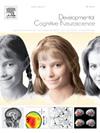不同静息状态神经标记在青少年行为抑制和社交焦虑中的作用
IF 4.9
2区 医学
Q1 NEUROSCIENCES
引用次数: 0
摘要
青少年社交焦虑最可靠的预测因素之一是行为抑制(BI)的气质特征,但这种关联存在相当大的异质性。基于静息状态脑电图的神经标记,即额叶α不对称和δ - β耦合(DBC),有望提高我们对青春期BI与社交焦虑症状之间关系的理解。本研究旨在:(1)阐明这些神经标记物、脑卒中和社交焦虑之间的关系;(2)分别考察额叶α不对称和脑卒中在脑卒中与社交焦虑之间的调节作用。参与者为97名青少年(Mage = 14.29岁,SDage = 0.98;84.4 %白人,3.1 %黑人,12.5 %多种族;54.6% (%女性)及其父母。父母报告青少年BI和青少年自我报告社交焦虑症状。此外,青少年在6分钟的静息任务中提供脑电图数据,从中得出额叶α不对称和DBC的测量结果。结果表明,较强的DBC与较高的社交焦虑症状直接相关,而与BI无关,并且不调节BI与社交焦虑之间的关联。相比之下,额叶α不对称与BI或社交焦虑没有直接关系,但与BI相互作用,预测对社交情境的回避和痛苦,因此,更大的相对右侧激活预示着更强的BI-社交焦虑联系。然而,这种效应在多重比较的校正中不存在。研究结果表明,高DBC可能标志着社交焦虑症状的普遍易感性,而额叶α不对称可能增加社交焦虑症状的风险,特别是在BI青年中。本文章由计算机程序翻译,如有差异,请以英文原文为准。
Disentangling the role of different resting-state neural markers of adolescent behavioral inhibition and social anxiety
One of the most reliable predictors of adolescent social anxiety is the temperamental profile of behavioral inhibition (BI), but there is considerable heterogeneity in this association. Resting-state EEG-based neural markers, namely frontal alpha asymmetry and delta-beta coupling (DBC), hold promise for improving our understanding of the relation between BI and social anxiety symptoms during adolescence. The current study aimed to (1) clarify the relation between these neural markers, BI, and social anxiety and (2) examine the moderating role, individually, of frontal alpha asymmetry and DBC on the BI-social anxiety link. Participants were 97 adolescents (Mage = 14.29 years, SDage = .98; 84.4 % White, 3.1 % Black, 12.5 % multiracial; 54.6 % female) and their parents. Parents reported on adolescent BI and adolescents self-reported social anxiety symptoms. Additionally, adolescents provided EEG data across a 6-minute resting task, from which measures of frontal alpha asymmetry and DBC were derived. Results indicated that stronger DBC was directly associated with higher social anxiety symptoms, but not BI, and did not moderate the association between BI and social anxiety. In contrast, frontal alpha asymmetry was not directly associated with either BI or social anxiety but interacted with BI to predict avoidance and distress to social situations, such that greater relative right activation predicted a stronger BI-social anxiety link. However, this effect did not survive correction for multiple comparisons. Findings suggest that high DBC may mark a general vulnerability for social anxiety symptoms, whereas frontal alpha asymmetry may potentiate the risk for social anxiety symptoms specifically among BI youth.
求助全文
通过发布文献求助,成功后即可免费获取论文全文。
去求助
来源期刊

Developmental Cognitive Neuroscience
NEUROSCIENCES-
CiteScore
7.60
自引率
10.60%
发文量
124
审稿时长
6-12 weeks
期刊介绍:
The journal publishes theoretical and research papers on cognitive brain development, from infancy through childhood and adolescence and into adulthood. It covers neurocognitive development and neurocognitive processing in both typical and atypical development, including social and affective aspects. Appropriate methodologies for the journal include, but are not limited to, functional neuroimaging (fMRI and MEG), electrophysiology (EEG and ERP), NIRS and transcranial magnetic stimulation, as well as other basic neuroscience approaches using cellular and animal models that directly address cognitive brain development, patient studies, case studies, post-mortem studies and pharmacological studies.
 求助内容:
求助内容: 应助结果提醒方式:
应助结果提醒方式:


